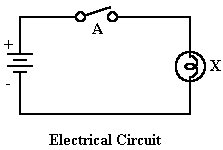| The Buffer (YES) Gate |
The Buffer is Yes logic element
that transfers the signal level at its input to its output.
It is used to isolate one circuit from another and give
the input signal a boost so that it can
drive higher-than-normal loads.
Buffer (YES) Gate Function
The logic symbol is a triangle
with one input and one output. Interestingly, the triangle
is also the shape used to represent an amplifier. And
the buffer is just that, since it boosts
the input signal current level. The truth table shows
a High on its input gives us a High on
its output.
|
Logic Symbol |
Truth Table |
In the equivalent electrical
circuit, when switch A is open (a Low condition), the lamp
is off and the output (X) is Low. When the switch
closes (a High condition), the lamp glows
and the output (X) is High.

The timing diagram conveys the
same message. At any time when the input is Low,
the output is Low, when the input is High, so is the
output.

The transistor equivalent is
easy to understand. With a Low at input point A, the
transistor remains off and the X output is held
Low through resistor R2.
But when the
input goes High, the transistor conducts and X
rises to near the supply voltage. The output
is High.

The Boolean expression states, "A equals X".
X = A